Every year, many construction workers are seriously injured at work. Therefore, when working on a construction site, it is important you always focus on safety, and that you protect yourselves correctly. If work cannot be planned, organised or carried out safely in other ways you can wear personal protective equipment.
The employer is responsible for providing the necessary protective equipment and for ensuring that employees use the equipment. The employer is also responsible for informing employees about the danger of not wearing protective equipment and for instructing employees in how to use, clean and store the equipment.
Personal protective equipment must be suitable for the work being performed and bear the CE marking. Choose and maintain the equipment so that it provides optimal protection, and ensure that the equipment has instructions for use. If personal protective equipment is needed at the workplace, this must always be indicated with signs.
Read below about how to protect yourselves with personal protective equipment.
Respiratory protective equipment – use the right filter
Particle filters:
Particle filter class P1 protects against dust to a limited extent - not against asbestos and silica dust.
Particle filter class P2 protects against harmful dust - including against asbestos and silica dust as well as liquid aerosols.
Particle filter class P3 protects like class P2 and additionally against bacteria and
virus.
Gas filters:
Type A protects against mineral turpentine, toluene, xylene and other organic solvents with a boiling point of at least 65°C.
Type B protects against, e.g. chlorine and cyanohydrates.
Type E protects against, e.g. sulphur dioxide.
Type K protects against, e.g. ammonia.
When do you need to use protective equipment?

Helmet
Wear a helmet where there is a risk of being hit by objects, material or tools, and where there is a risk of being crushed.

Fall protection
Wear fall protection where collective safety arrangements, such as railings, are not possible. Fall protection equipment can be used for short-term roof work lasting up to about 4 hours. Note that fall prevention equipment is safer than fall arrest equipment.

Ear defenders
Wear ear defenders when exposed to hearingdamaging noise exceeding 85 dB(A).

Workwear
Wear reflective clothing when working in areas with traffic.

Eye protection or visor
Wear eye protection when work involves a risk to the eyes, and wear a visor if you need to protect your entire face. For example, where there is a risk of flying particles and dust or spatter from corrosive gases or exposure to harmful radiation in connection with welding.

Protective footwear
Wear protective footwear if objects can fall on your feet.
Protective footwear should have protective soles when there is a risk of treading on sharp or pointed objects.

Respiratory protective equipment
Wear respiratory protective equipment, e.g. when there is a risk of inhaling dust, smoke, gases or vapours during work.
Remember to use the correct particle and gas filter.








